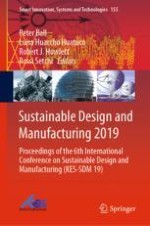2019 | Buch
Sustainable Design and Manufacturing 2019
Proceedings of the 6th International Conference on Sustainable Design and Manufacturing (KES-SDM 19)
herausgegeben von: Dr. Peter Ball, Dr. Luisa Huaccho Huatuco, Prof. Robert J. Howlett, Prof. Rossi Setchi
Verlag: Springer Singapore
Buchreihe : Smart Innovation, Systems and Technologies
